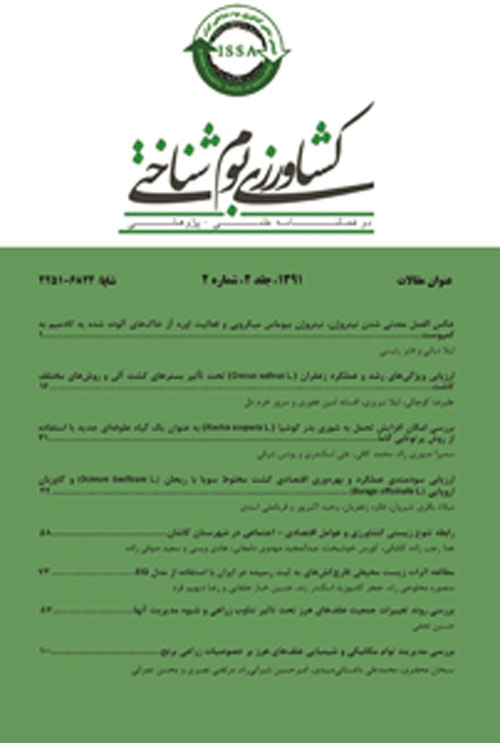Study of livestock grazing effects on chemical soil properties and surface vegetation of rangeland (case study: Makhmalkouh, Lorestan province)
Author(s):
Abstract:
Introduction
There is a very close relationship among the various active elements within rangelands, which affect their sustainability and productivity. The chemical characteristics of the soil are among the most important factors in fertility and, consequently, in the density and type of plant cover of rangelands. Livestock grazing impacts on some qualitative soil properties, such as its physical and chemical and biological characteristics and including more reactive parameters such as biological activity, organic matter, bulk density, concentration of nutrients, etc. These have been reported for different time periods in rangeland ecosystems. The objective of this research was to investigate changes in chemical characteristics (EC, pH, available form of phosphorus and potassium, calcium carbonate, moisture content, etc.) and plant cover in three areas under treatments of heavy grazing (critical area), normal grazing (key area) and excluded from grazing (reference area).Materials And Methods
This study was conducted in Makhmalkoh region located in north of Khormabad City and using soil samples from 0-15 and 15-30 cm depth from the three selected areas (reference, key and critical) with different grazing intensities. Soil samples were collected five times over 2 years and at four-month intervals from five one-hectare paddocks in each area. Soil EC, pH in saturated extract and OM, total nitrogen and available P and K were all determined using standard methods and the changes over time were compared. Plant cover density in each area was investigated using the plate method, and at three times, by determining the percentage of plant crown covers for each growth form and the percentage of bare soil and litter in each plate. The experiment was conducted based on a factorial completely randomized design. Results And Discussion
The results showed that the effects of area (grazing intensity) and time of sampling (seasonal variation) were significant for total N, OM, and available P and K PConclusion
Differences in grazing intensity affect the percentage of plant cover and plant species in a rangeland. The highest plant cover was observed in the key area and the least in the critical area. Inside the key area, shrubs were not observed. Also, a decrease in the plant cover percentage of grasses and an increase in shrubs were observed with an increase in grazing pressure. Decrease in soil OM and moisture content along with concentration of available P and K in soils of the studied area were observed due to grazing, which reduced soil fertility. Changes were more obvious for the 0-15 cm soil depth due to addition of animal manure, plant residue on the surface soil and more roots. A reduction of more than 10 percent in plant cover and an organic matter reduction due to intensive grazing can cause severe erosion and growth of unfavorable plants, which requires suitable management practices of livestock grazing and plant cover. Keywords:
Language:
Persian
Published:
Journal of Agroecology, Volume:6 Issue: 1, 2016
Page:
98
magiran.com/p1586441
دانلود و مطالعه متن این مقاله با یکی از روشهای زیر امکان پذیر است:
اشتراک شخصی
با عضویت و پرداخت آنلاین حق اشتراک یکساله به مبلغ 1,390,000ريال میتوانید 70 عنوان مطلب دانلود کنید!
اشتراک سازمانی
به کتابخانه دانشگاه یا محل کار خود پیشنهاد کنید تا اشتراک سازمانی این پایگاه را برای دسترسی نامحدود همه کاربران به متن مطالب تهیه نمایند!
توجه!
- حق عضویت دریافتی صرف حمایت از نشریات عضو و نگهداری، تکمیل و توسعه مگیران میشود.
- پرداخت حق اشتراک و دانلود مقالات اجازه بازنشر آن در سایر رسانههای چاپی و دیجیتال را به کاربر نمیدهد.
In order to view content subscription is required
Personal subscription
Subscribe magiran.com for 70 € euros via PayPal and download 70 articles during a year.
Organization subscription
Please contact us to subscribe your university or library for unlimited access!


